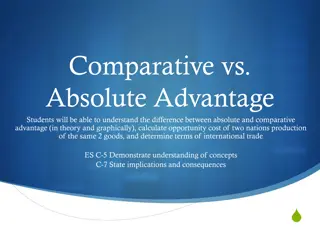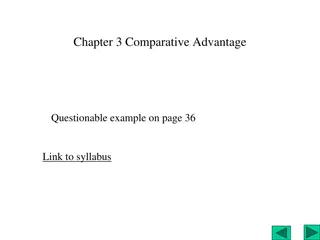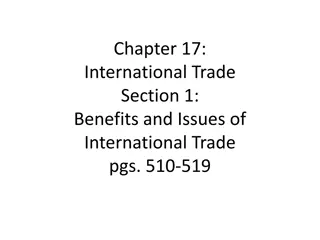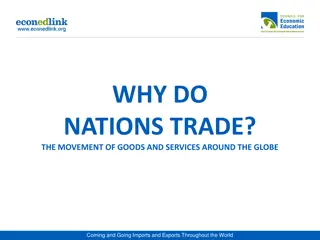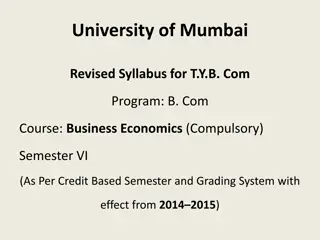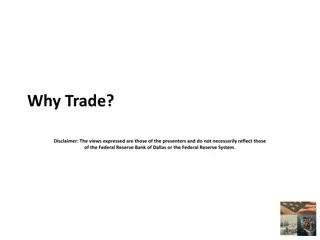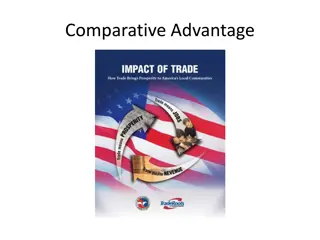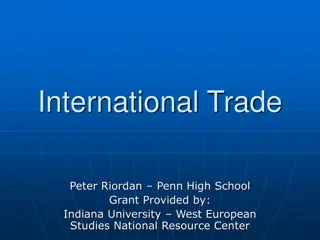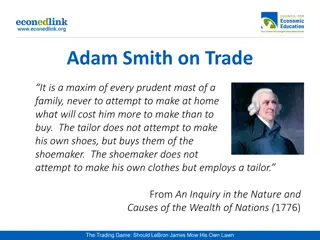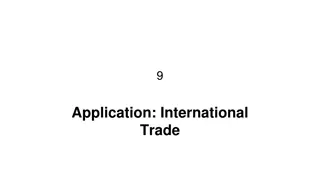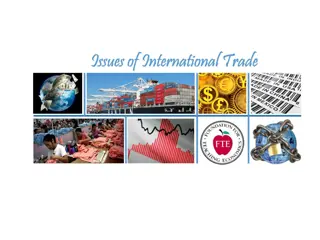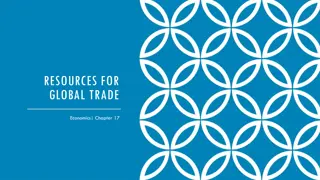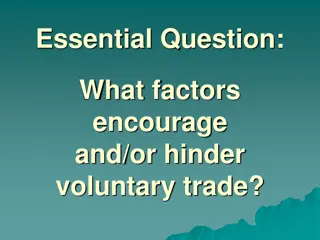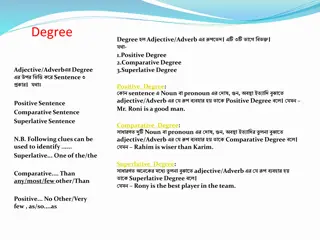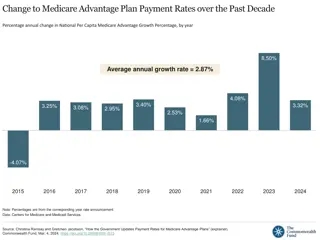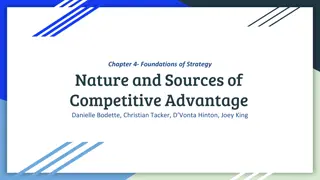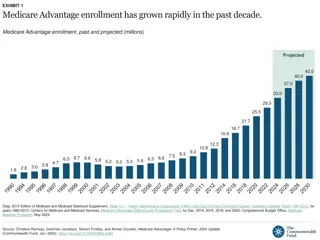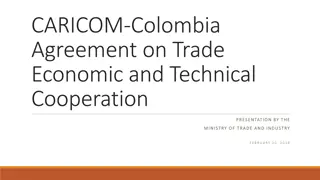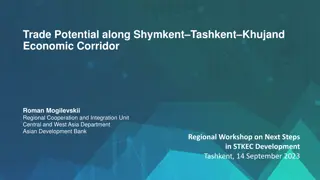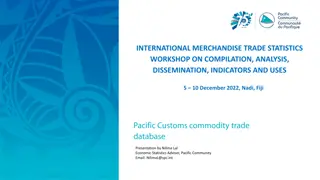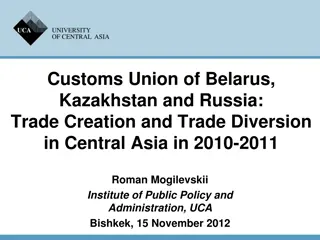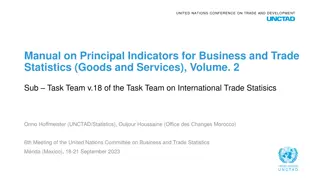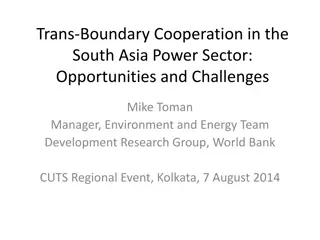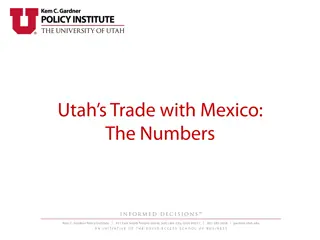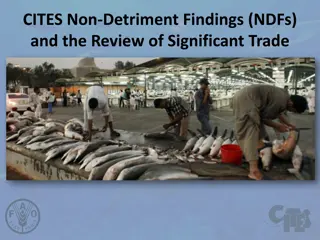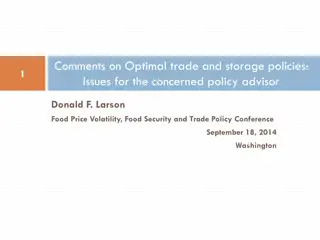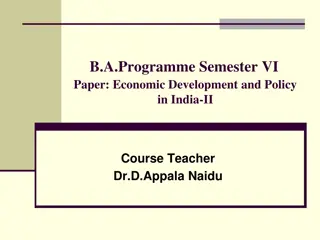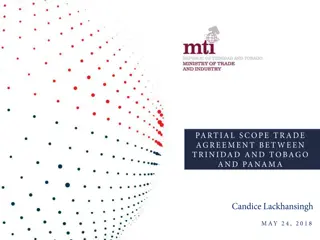Understanding the Gains from Trade Through Comparative Advantage
Discover the economic benefits of trade, absolute and comparative advantage, and how specialization and exchange enhance output. Learn about the minimum and maximum terms of trade and why the gains from trade may not be apparent to many. Explore key concepts like opportunity cost, constant costs, and more using visuals and practical examples.
Download Presentation

Please find below an Image/Link to download the presentation.
The content on the website is provided AS IS for your information and personal use only. It may not be sold, licensed, or shared on other websites without obtaining consent from the author. Download presentation by click this link. If you encounter any issues during the download, it is possible that the publisher has removed the file from their server.
E N D
Presentation Transcript
20a The Gains from Trade This web quiz may appear as two pages on tablets and laptops. I recommend that you view it as one page by clicking on the open book icon at the bottom of the page.
20a - Macro Why We Trade: Comparative Advantage The Economic Benefits of Trade Absolute Advantage Comparative Advantage The Gains from Trade The Terms of Trade
20a - Macro Why We Trade: Comparative Advantage Outcomes why do the gains from trade appear to be hidden from many people? what is the economic basis for specialization and exchange (trade)? calculate the opportunity costs using straight line production possibilities define and find absolute advantage and comparative advantage using straight line (constant costs) production possibilities calculate how specialization and trade increases output using the production possibilities tables or graphs of two different countries (i.e. calculate the gains from trade) compute the minimum and maximum terms of trade
20a - Macro Why We Trade: Comparative Advantage Key Terms opportunity cost, constant costs, increasing costs, absolute advantage, comparative advantage, gains from trade, free trade, terms of trade, minimum and maximum terms of trade
1. Specialization in production is economically beneficial primarily because it: 1. Allows everyone to have a job they like 2. Facilitates trade by bartering 3. Guarantees full employment 4. Permits more output from the same resources
1. Specialization in production is economically beneficial primarily because it: 1. Allows everyone to have a job they like 2. Facilitates trade by bartering 3. Guarantees full employment 4. Permits more output from the same resources
2. Use the PPC below. Which is possible only with trade? 1. A 2. B 3. C 4. D 5. E
2. Use the PPC below. Which is possible only with trade? 1. A 2. B 3. C 4. D 5. E
3. If we assume both Pakistan and Malaysia have the same amount of resources, who has an absolute advantage in producing rice? 1. Both countries 2. Neither country 3. Pakistan 4. Malaysia
3. If we assume both Pakistan and Malaysia have the same amount of resources, who has an absolute advantage in producing rice? 1. Both countries 2. Neither country 3. Pakistan 4. Malaysia
4. If Malaysia has an absolute advantage in production both wheat and rice why can Malaysia still benefit from trade with Pakistan? 1. Malaysia has constant costs 2. Malaysia has increasing costs 3. Each country has different opportunity costs 4. Pakistan is better at producing wheat
4. If Malaysia has an absolute advantage in production both wheat and rice why can Malaysia still benefit from trade with Pakistan? 1. Malaysia has constant costs 2. Malaysia has increasing costs 3. Each country has different opportunity costs 4. Pakistan is better at producing wheat
5. In Pakistan, the op. cost of 1 Wheat is: 1. 0 Rice 2. rice 3. 2/3 Rice 4. 20 Rice3
5. In Pakistan, the op. cost of 1 Wheat is: 1. 0 Rice 2. rice 3. 2/3 Rice 4. 20 Rice3
6. Who should export what? 1. Pakistan both wheat and rice 2. Pakistan wheat, Malaysia rice 3. Pakistan rice, 4. Malaysia wheat 5. Malaysia both wheat and rice
6. Who should export what? 1. Pakistan both wheat and rice 2. Pakistan wheat, Malaysia rice 3. Pakistan rice, Malaysia wheat 4. Malaysia both wheat and rice
7. Assume before specialization, Pakistan is at C and Malaysia at B , If they specialize 100%, then the gains will be: 1. 45 wheat and 20 rice 2. 20 rice 3. 5 wheat 4. 15 wheat
7. Assume before specialization, Pakistan is at C and Malaysia at B , If they specialize 100%, then the gains will be: 1. 45 wheat and 20 rice 2. 20 rice 3. 5 wheat 4. 15 wheat
8. Which of the following would be an acceptable terms of trade? 1. 1 rice for wheat 2. 1 rice for 1 wheat 3. 1 rice for 1 wheat 4. 1 rice for 2 wheat
8. Which of the following would be an acceptable terms of trade? 1. 1 rice for wheat 2. 1 rice for 1 wheat 3. 1 rice for 1 wheat 4. 1 rice for 2 wheat
Pakistan: 1W = 2/3 R 1W=1/2R 1 R = 1 W 1R=2W So Pakistan sells rice Min. they ll accept= 1 W Malaysia buys rice: Max they ll pay = 2W Malaysia: So the terms of trade must be between: 1R for 1 W and 1R for 2W. 1R for 1 W is possible
9. Which of the following would be an acceptable terms of trade? 1. 1 W for 1/2 R 2. 1 W for 3/5 R 3. 1 W for 1 R 4. 1 W for 2 R
9. Which of the following would be an acceptable terms of trade? 1. 1 W for 1/2 R 2. 1 W for 3/5 R 3. 1 W for 1 R 4. 1 W for 2 R
10. Why do the benefits of free trade appear to be hidden? 1. Politicians don t want to tell us 2. Unions oppose free trade 3. The benefits of trade are spread among many, the costs fall on a few 4. The benefits are less than the costs
10. Why do the benefits of free trade appear to be hidden? 1. Politicians don t want to tell us 2. Unions oppose free trade 3. The benefits of trade are spread among many, the costs fall on a few 4. The benefits are less than the costs


